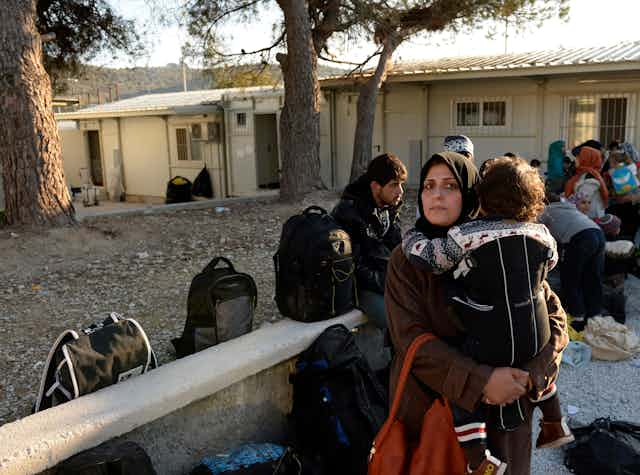Even before the arrival of COVID-19 refugee rights were in trouble. For decades politicians in Europe, the US and some countries in Africa, Asia and Latin America have sought to manufacture and manipulate fears around migration for political ends.
In Europe the politics of migration took a particularly toxic turn with the so-called “migration crisis” of 2015. While refugees from Syria, Afghanistan, Iraq and countries across Africa drowned at sea or became trapped in badly managed asylum systems, EU member states jostled for position, closing borders, building fences and restricting, before eventually criminalising, search-and-rescue efforts.
Across the Atlantic, similar political forces were at play. Donald Trump made immigration one of the centrepieces of his 2016 presidential campaign, with emphasis on stopping migration from Mexico by “building a wall” and significantly reducing the number of refugees able to enter the US through what had once been the world’s largest refugee resettlement programme.
Other countries with similar protections have also been hostile. Although the laws protecting refugees in South Africa are among the most progressive in the world, they are hard to access in practice and associated with long procedural delays. Many refugees remain entirely undocumented and without access to rights. Meanwhile xenophobic violence has surged. This xenophobia, rooted in a system of deep-rooted economic and social inequality that has carried on long since the end of apartheid, is often blamed on migrants, an idea actively promoted by the South African government.
Refugees and asylum seekers only make up around 10% of all international migrants. Yet they and the systems designed to protect them have come to be seen as “touchstone issues” for a wide range of other anxieties and concerns. It won’t be a surprise to learn that many of these issues only escalated for refugees after the arrival of COVID-19.
Refugee vulnerabilities
The consequences of adding the pandemic to these already serious issues have been depressingly predictable. Many refugees live in poor housing and overcrowded conditions in camps, informal settlements and urban areas. In these settings, the terms “stay home”, “stay safe”, and “social distancing” carry very little meaning. Refugees are also especially vulnerable to the economic impacts of the pandemic because they are 60% more likely than host populations to be working in highly affected sectors, such as accommodation and food services, manufacturing and retail. COVID-19 has also made it more difficult for refugees to access social safety nets and aid provided by humanitarian organisations, many of which have been forced to withdraw.
In South Africa, refugees, asylum seekers and other migrants are unable to access the same pandemic-related financial support, food parcels and healthcare services that others receive because the application process requires identity documents that many of these groups simply don’t have.

When fires destroyed the Moria camp on the Greek island of Lesbos in September 2020, 13,000 people were forced to live and sleep on the streets with almost no assistance, no hygiene measures and no sanitation facilities. Most were then moved to a new camp, Moria 2.0, where they live in flimsy tents, some of which are pitched just 20 metres from the sea and have already been flooded and battered by strong winds. Although the camp was built well into the pandemic, its design failed to prevent the spread of COVID-19 – and hundreds subsequently tested positive.
Border closures and access to protection
The issues facing refugees aren’t just a direct consequence of the pandemic. Some governments are using COVID-19 as an excuse to double down on border closures as well as using migration policy to demonstrate the robustness of their response to it. Although countries are entitled to close borders on health grounds, they must still provide access to asylum for those seeking protection from persecution. In practice this isn’t the case – there is evidence of pushbacks from Europe, the US and other parts of the world.

Worse still, refugees and other migrants have been blamed for the spread of the virus by populists who wish to exploit the pandemic for political gain. In Hungary, the pandemic has been used as an excuse to pass emergency laws closing down the country’s already very restrictive asylum system. Although steps had already been taken to prevent the arrival of boats into Italian ports, Italy’s powerful far-right opposition party used the virus to attack its fragile government, attempting to tie COVID-19’s spread to wider issues of border controls and migration. Thousands of asylum seekers are currently quarantined on ships off the Italian coast.
Elsewhere, governments have taken advantage of the pandemic to put internationally opposed refugee policies into practice. In Bangladesh for example, around 1600 Rohingya refugees have been relocated from camps in Cox’s Bazar to Bhasan Char in the Bay of Bengal, a low-lying and previously uninhabited island completely cut off from the mainland and vulnerable to cyclones and flooding. Concerns about COVID-19 and overcrowding have provided the perfect pretext to push this controversial policy forward.
The future for refugee rights
A year after the arrival of COVID-19, the future for refugee rights is more uncertain than ever. By weaponising fear, COVID-19 has become a convenient cover for reducing refugee rights and introducing restrictive policies that could become permanent once the pandemic is over. In this context it seems likely that the pandemic will accelerate the course of history in relation to refugee rights, rather than changing its direction.

